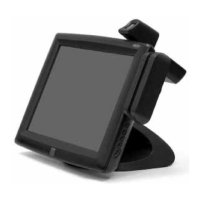USB HID Keyboard Emulation Swipe Reader
Tk1 SS = % (7-bit start sentinel)
Tk2 SS = ; (ISO/ABA 5-bit start sentinel)
@ (7-bit start sentinel)
Tk3 SS = + (ISO/ABA start sentinel)
! (CA drivers licence start sentinel)
# (AAMVA start sentinel)
& (7-bit start sentinel)
ES = ? (end sentinel)
CR = (carriage return) (0D hex)
All data will be sent in upper case regardless of the state of the caps lock key on the keyboard. If
no data is detected on a track then nothing will be transmitted for that track. If an error is
detected on a track the ASCII character E will be sent in place of the track data to indicate an
error.
The card data format for all programmable configuration options is as follows:
[P11][P13][Tk1 SS][Tk1 Data][ES][LRC][P14][P5][P13][Tk2 SS][Tk2
Data][ES][LRC][P14][P5][P13][Tk3 SS][Tk3 Data][ES][LRC][P14][P5][P12]
where:
ES = ? (end sentinel)
LRC = Longitudinal redundancy check character
P5 = Terminating character
P11 = Pre card character
P12 = Post card character
P13 = Pre track character
P14 = Post track character
Tk1 SS = % (7-bit start sentinel)
Tk2 SS = ; (ISO/ABA 5-bit start sentinel)
P6 (7-bit start sentinel)
Tk3 SS = P8 (ISO/ABA start sentinel)
P7 (CA drivers licence start sentinel)
P9 (AAMVA start sentinel)
P10 (7-bit start sentinel)
All fields with the format P# are programmable configuration property numbers. They are
described in detail later in this document.
PROGRAMMABLE CONFIGURATION OPTIONS
This device has a number of programmable configuration properties. These properties are stored
in non-volatile EEPROM memory. These properties can be configured at the factory or by the
end user using a program supplied by MagTek. Programming these parameters requires low
level communications with the device. During normal device operation, the device acts like a
USB HID keyboard so the host operating system takes care of all low level communications with
12

